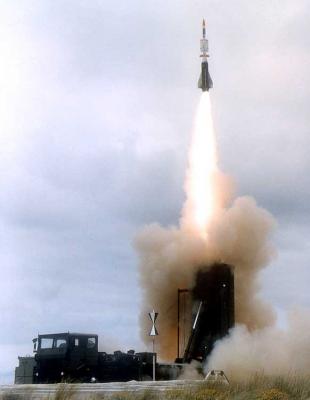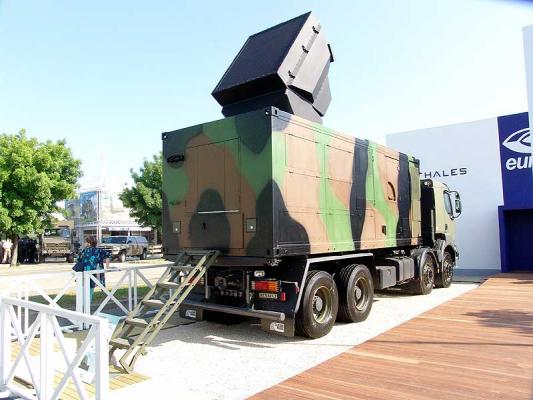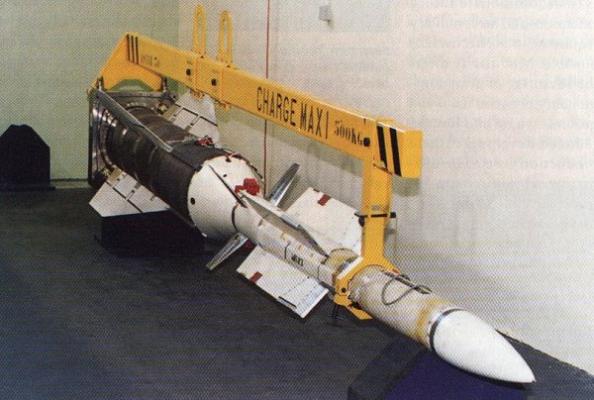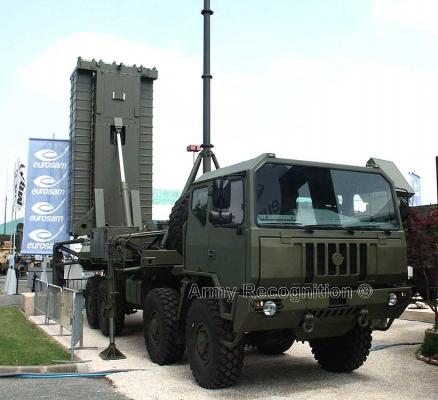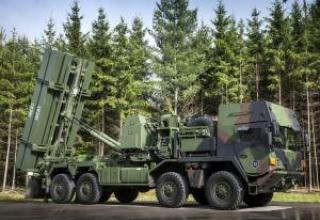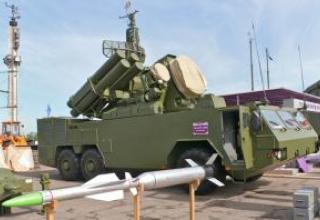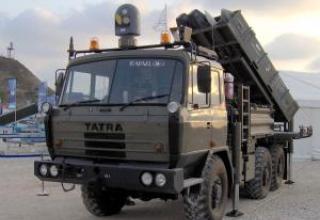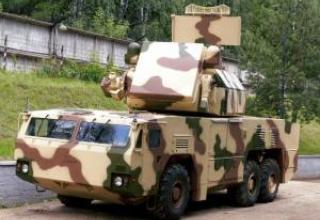SAMP-T (EUROSAM Land system) is designed for air defense of mechanized units and troops performing marches, as well as air defense of important stationary objects from a massive attack of a wide class of air targets, ranging from tactical missiles, all types of aircraft and ending with a variety of unmanned aerial vehicles in all weather conditions, when the enemy's use of various obstacles of high intensity.
The developer and manufacturer of the complex is a European consortium "Eurosam". The consortium was established in June 1989 by Aerospatiale. , "Alenia" and "Thompson-CSF" in order to create and promote the armament of FSAF - Forward SurfacetoAir Family of missile systems. "Eurosam acts as a system integrator of projects on creation of sea and land variants of air defense system. The program of FSAF family of complexes development includes a number of innovations, namely: modular system layout to achieve air transportability, minimization of the total number of complex elements, novelty of applied technological solutions to meet the specific performance characteristics of the system, the possibility of modernization of the complex systems throughout the whole cycle of operation, the minimum maintenance of the complex equipment by persons of combat calculation during its operation. All systems included in the FSAF family of complexes consist of replaceable elements that meet the above requirements.
The peculiarity of SAMP-T SAMP-T is that it is one of the variants of the modular range of FSAF family of SAMPs. In addition to SAMP-T SAMs, SAAM ( PAAMS ) shipborne SAMs of various configurations are also assembled from standard modules for equipping French and Italian Navy ships. The means of destruction in all sea and land-based complexes are unified anti-aircraft guided missiles (SAMs) of the "Aster" family. Aster-30" SAMP-T and designed for the ship version of "Aster-15" are maximally unified, have a modular design and actually differ only in terms of launch accelerators. The flight development tests of the Aster SAM system were completed in 1999. Complex flight tests of SAMP-T SAM system were completed in 2005 and in 2006 the system was adopted for service.
After the completion of the Aster rocket tests, a number of programs for its further modernization were adopted. According to the existing plans, this work is planned to be carried out in several stages: in the form of the "Aster" rocket block 1, which has been under development since 2000, with subsequent transition to the prospective versions of block 2 and block 3. On November 12, 2003 a contract ($3.5 billion) was signed with the Eurosam consortium for the full-scale development and production of SAMP-T Block 1 SAMP systems with Aster block 1 missiles. This SAM system, designed to provide defense for the new NATO and European rapid reaction forces, is to be adopted in 2007. The missile used in this SAM will have increased effectiveness in intercepting ballistic missiles with a range of up to 600 km, various types of high-precision weapons and UAVs. The terms of the contract signed in November 2003 provide for production until 2014. 18 SAM batteries for the French and Italian armed forces. In total, the contract provides for the production of 1,400 missiles, auxiliary equipment and simulators for the three states.
At the same time as the contract was signed by a member of the Eurosam consortium, EADS began negotiations with the French Arms Manufacturing Commission (DGA) on a demonstration programme designated SAMP-T Block 2. It is expected that this programme, worth 50-100 million euros, will take 3-5 years to implement. In the course of its implementation, a number of promising key technologies are to be explored, including pointing the missile at the final intercept area, increasing the effectiveness of ballistic targets (with a range up to 1500-2000 km) and some system solutions.
To carry out this program, DGA has commissioned two experimental systems to demonstrate the capabilities of SAMP-T Block 2: a EUR 60-80 million early detection satellite demonstration and a medium-range radar. The 70 million euros worth of radar demonstrator work is known as M3R. M3R, which is intended to provide a defense area of up to 1,000 km, is being actively supported by the Netherlands, which showed interest in SAMP-T Block 2 shortly after the United States ceased work on the Standard SM-2 Block 4A ship-based anti-ship missile. Eurosam's partners in this work could also be Germany and Italy, which continue to explore a combination of another multinational MEADS and SAMP/T SAMP.
Composition:
The SAMP-T complex includes:
- Thompson-CSF ARABEL multifunction radar with phased array antenna;
- combat control cabin - FCU (Fire Control Unit), which houses the control system equipment that processes all information about the air situation in real time, as well as two display system consoles;
- Aster-30 missiles;
- self-propelled vertical launch vehicles on the Astra/Iveco or Renault-TRM-10000 vehicle chassis (8x8 wheel arrangement) with launch modules for 8 combat-ready missiles in transport and launch containers.
The multifunctional ARABEL X-band radar allows for space surveillance, target detection and tracking, as well as pointing missiles at the target by transferring control commands on board. The implementation of such a multifunctional mode of operation of the radar is provided by powerful computing facilities of the complex. The radar looks through the azimuthal space around and from -5° to +90° in the angular plane during one turn of the antenna, carried out in 1s. The dimensions of the electron beam is 2°. The range of target detection up to 80 km. The number of simultaneously detected targets - up to 130, the number of simultaneously accompanied target traces - 10. ARABEL radar is characterized by a high degree of control over radiation modes, instantaneous adjustment of the frequency of the sounding signal, adaptive processing of the received reflected signal and different time of target irradiation, the narrow size of the sounding beam. A state recognition system (IFF / NIS) can be added to the multifunction radar, which integrates with the multifunction radar or has its own radiation and signal reception path.
SAMP-T" SAM system has minimum reaction time and high firing rate (8 missiles can be launched in 10 seconds).
As a means of destruction in the SAMP-T SAM system, a two-stage rocket "Aster-30" is used (see diagram) The rocket has an active radar CNS, operating in the frequency range of 10-20 GHz. It is a modification of the homing head of the MICA air-to-air guided missile. Diameter of the CNS is 0.18 m, length (including the unit of electronic guidance equipment) is 0.6 m. Homing of the missile at most of its flight path to the target is carried out by the command-inertial system, and homing using the information received from the SOS is only in the final section. It is provided that the search and capture of the target by the head is carried out during the flight of the missile.
To increase the missile's maneuverability, the Aster-30 uses an original device of combined transverse air-gas-dynamic proportional control, designated PIF-PAF (Pilotage en Force-Pilotage Aerodinamique Fort). PIF-PAF is a combined system that uses, in addition to traditional aerodynamic control surfaces, a special transverse control engine (CNC) located near the mass center of the LSD. PIF-PAF "Aster-30" is designed as a solid fuel gas generator with four slotted nozzles equipped with control valves. The slotted nozzles are located inside the cruciform wings of the rocket. The DPU is activated approximately 1s before the target and its thrust is adjusted according to the guidance system commands. The maximum transverse overload created by the DPU is 12 units and significantly increases the probability of hitting SAMP-T priority targets. According to the developers, direct hits completed about half of the 30 successful test launches of various variants of "Aster". Expected characteristics of the CCP: maximum thrust (one nozzle) - 750 kggs, length / diameter of the chamber of the CCP - 450/180mm. One of the complex technical problems in the development of such a circuit is the creation of reliable high-speed valves that regulate the flow of high-temperature combustion products. The use of a two-stage circuit has allowed the "Aster-30" rocket to reduce the weight of the combat stage (about 100 kg) and, as a result, to reduce the maximum thrust level of the CCP, which made it easier to create a CCP with adjustable thrust. Placement of nozzles inside the cruciform wings made it possible to carry the expiring jets of the DPU behind the swing of the second stage of the missile's tail fins, which minimizes undesirable "interaction effects" and ensures the control and stabilization of the missile with the tail aerodynamic rudders. The fee for such a solution is an increase in the transverse dimensions of the transport and launch container and the launch module (as a consequence of the impossibility to fold the wings with the nozzles located in them).
The "Aster-30" rocket is equipped with a shrapnel-type combat unit with programmable delay of non-contact fuse operation.
A typical SAMP-T battery consists of a combat control cabin with a multifunction ARABEL radar and 6 launchers at a distance of up to 10 km from the control cabin. All subsystems are operated by two members of the combat calculation. It is possible to integrate other optoelectronic reconnaissance means into the complex. The complex can operate independently, with target designation from the radar remote detection and as part of an integrated air defense system.
Usually the SAMP-T system combat operation is as follows. When the alarm is announced, the operators of the combat control cabin bring all elements of the complex into combat position, providing their power supply. Multifunction radar antenna ARABEL, rotates at a speed of 1 r / s, thereby providing a circular view of the air space in the azimuthal plane. If necessary, the multifunction radar can be assigned sectors of responsibility with priority for detection and firing of detected targets. In these sectors, a target is detected and identified in a single antenna revolution by additional sensing of the area where the primary target was detected. If the second sounding confirms the detection of a target, the next antenna revolution will tie its route. Information about the target path is received in the cockpit and is displayed on the displays. Computer means prolong the future mark taking into account the assumed target movement, its speed and character of movement. Each target is assigned an individual number (there is a sign of its own and someone else's target). When the target enters the launch zone of the complex, the combat control cabin gives commands to the appropriate launchers, these commands are prepared for the launch of one or two missiles "Aster-30".
Further, the combat control center issues commands to launch one or two missiles. On the launcher, after receiving a command to launch, information about the direction and other parameters of target movement, as well as the value of the angle of inclination of the missile during its vertical launch is transmitted to the missile. Accordingly, preparations are made to capture for escorting launch missiles. The missile then undergoes a vertical launch and leaves its transport and launch container. Modes of operation of the phased array antenna multifunctional radar allows you to detect and capture the escort of a missile launched "Aster-30", then using the computational tools to form its route. After exiting the transport and launch container, the missile is inclined towards the intended rendezvous point with a target.
The missile's route is displayed on indicators at the battle control point. The coordinates of the target and its movement parameters are updated after a second and are transmitted to the missile to guide it to the intended rendezvous point. After the rocket accelerator has finished its work, the main engine is started with a certain time delay. The missile's flight path is formed in such a way that its proximity to the target allows it to capture the target by the missile's homing head, which is included in the work at a certain point of the flight path. Once the main engine is running, the missile continues to fly to the target. To control the flight, the rudders and wings of the missile are used, and if necessary, the PIF guidance system is used in the final flight section in order to minimize miss and maximize damage to the target.
Each battery can simultaneously point 16 missiles at different targets. Information on the number of missiles consumed and ready to be launched on each launcher is used during combat to assign new missiles to fire newly discovered targets.
The Aster block-1 upgrade programme aims to improve the performance of the missile for missile defence purposes. The overall layout of the missile remains unchanged. The modernized ARGSN missiles have improved characteristics to work at high flight speeds, the control system used a more powerful BCVM, introduced advanced algorithms to capture the target and select the optimal time to blow up the combat unit. The missile's combat unit is being improved, which includes two different types of fragments and a new blast device that provides directional BC action towards the target.
The prospective version of "Aster" block-2 is designed to effectively intercept a wide range of ballistic targets, the appearance of which is projected for 2010-2012, and includes a wide range of possible options. The first way is to implement the existing technologies with the invariable design of the missile's marching stage, whose characteristics meet the requirements for high-altitude missile defense systems. It can be replaced or adapted for new tasks of the missile GSN, the system of remote detonation of combat unit, on-board computer, the marching engine and gas-dynamic control subsystem RIF. In order to increase the intercept area and to enable the interception of targets at high altitudes, various options are also being investigated to equip the missile with large accelerators that will remain compatible with the existing Aster-30 LRBMs. Under another concept, a missile equipped with a larger diameter marching stage and dual-band CNS is being studied. The third option is a missile that uses a large wingless accelerator and is equipped with a kinetic kill interceptor. However, as noted by the developers themselves, the use of wingless accelerators will reduce the effectiveness of intercepting targets at short ranges and several other shortcomings.
According to the concept "Aster" block-2 will be able to provide direct hit to ballistic targets, including those that can maneuver in the final stage of flight. One of the most critical elements of this research is the study of technologies related to the missile's COS. The future Aster can be equipped with infrared COS, similar to that used on an MICA aircraft missile, and will be capable of targeting infrared or dual-band IR/RL waves when intercepting ballistic targets at relatively low altitudes.
Another area of research under the block-2 programme is work to improve the gas-dynamic control system of the PIF missile. The solutions proposed today include:
- Implementation of the rocket's flight speed maintenance mode and gas-dynamic control function using one solid fuel charge;
- use of one solid fuel charge to implement several pulses of PIF system;
- creation of a PIF system based on the use of two or three solid propellant charges.
Characteristics:
| Defeat range, km : - aircrafts - ballistic missiles |
3-100 3-35 |
| Defeat height, km | 25 |
| Maximum speed of ZUR, m/sec | 1400 |
| Average speed of ZUR, m/sec. | 900-1000 |
| Maximum overload : - at flight altitude H=0 - at flight altitude H=15km |
60g 15g |
| Weight BC, kg | 15-20 |
| Starting mass ZUR, kg | 510 |
| The marching step: - length, m - diameter,m - weight,kg |
2.6 0.18 100-110 |
| Start step : - length, m - diameter,m - wingspan, m - weight,kg |
2.3 0.54 0.92 380-400 |
Testing:
In 1974, the RPU-14 rocket launcher was still in service with the Soviet Army and was used in mountainous conditions.
Sources:
- Е.Г. Болотов, Б.Я. Мизрохи "Новое поколение зенитных управляемых ракет средней дальности", Специальный выпуск журнала "Полет" к 50-летию МКБ "Факел", 2003 г.
- Василин Н.Я., Гуринович А.Л. "Зенитные ракетные комплексы" .-Мн.: ООО "Попурри", 2002- 464с.
- Aster : Le top de l'anti-missile
- Зенитная ракетная система "АСТЕР"/Вестник ПВО/
- В. Коровин "Новые варианты ракет "АСТЕР". Журнал "ВКО" №2 (5) 2002
- SAMP-T - ASTER 30 /Ground Based Air Defence/
- SAMP-T Land Based Air Defense System MBDA (Europe)
- ASTER hit-to-kill Missile Interceptors /Eurosam/
